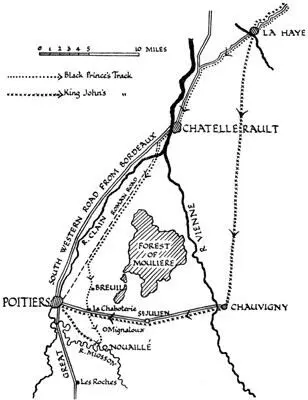The Black Prince made back westward after “Grey Mutton,” thinking, perhaps, to cross the Loire at Blois, and two days out from Vierzon (rather over twenty miles) he made the only assault upon fortifications which he permitted his men in the whole campaign. This was an attack upon the Castle of Romorantin, in which “Grey Mutton” had taken refuge.
It was not the moment for delay. Edward knew that the French army must now be somewhere in the neighbourhood; he had already touched lance with one small French force; but he had his teeth into the business and would not let go his hold. The outworks were taken early in the affair. The keep held out for four days more, surrendering at last to fire upon the 3rd of September.
The season was now full late if the Black Prince intended a return to the south. But, as we have seen, he no longer entirely intended such a retreat. He had already begun to consider the alternative of crossing the Loire and joining his brother’s force beyond it. He had information, however, that the bridges directly in front of him were cut. It is not easy to reconcile this with the passage immediately afterwards of the French army. But the most vivid, and perhaps the most accurate, account we have of this march not only tells us that the bridges were cut, but particularly alludes to the high water in the Loire at that moment. It is a significant piece of information, because no river in Europe north of the Pyrenees differs so much in its volume from day to day as does the Loire, which is sometimes a trickle of water in the midst of sandbanks, and at other times a great flood a quarter of a mile across, and twenty feet deep, like the Thames at London.
At any rate, from Romorantin, Prince Edward made for Tours, a distance of fifty miles as the crow flies, and a march of precisely five days. It will be observed that his plotted rate of marching at ten miles a day was most accurately maintained.
Now from his camp in front of Tours, Edward behaved in a fashion singular even for the unbusinesslike warfare of that somewhat theatrical generation. He sat down, apparently undecided which way to turn, and remained in that posture during the remainder of September the 8th, all the next day, September 9th, and all the next day again, the 10th. There could be no question of attacking Tours. It was a strong, large, and well-defended town, and quite beyond the power of the Black Prince’s force, which was by this time encumbered with a very heavy train of waggons carrying his booty. But while he was waiting there (and he could see, says one account, the fires of his brother’s army by night beyond the Loire), his enemy, with such forces as he had been able to collect, was marching down upon him.
The King of France had begun to get men together at Chartres upon the same day that his rival had reached Vierzon, the 28th of August. Five days later, just when Romorantin Castle was surrendering, he had broken up and was marching to the Loire. And upon the same 8th of September which saw the Black Prince pitch his tents under the walls of Tours, the first bodies of the French command were beginning to cross the Loire at the two upper points of Meung and Blois, while some of them were preparing to cross at Tours itself.
Yet so defective was Edward’s information that it was not until Sunday, September 11th, that news reached him of King John’s movements. He heard upon that day that the French king himself had crossed at Blois, thirty miles up river behind him. Edward at once broke camp and started on his retreat to the south. After him as he went followed the French host, which had combined its forces after its separate passages of the river.
It is important, if we are to understand what follows, to appreciate both the quality and the numbers of those whom the King of France had been able to gather. He had with him, by the still necessary and fatal military weakness of French society, only those loose feudal levies whose lack of cohesion had accounted ten years before for the disaster of Crécy. But John commanded no such host as Philip had nominally led in the Picardy Campaign against Edward III. At the most, and counting all his command, it was little if at all superior in numbers to that of the Black Prince. He hoped, indeed, to increase it somewhat with further levies as his progress southward advanced, and we shall see that his ultimate entry into the town of Poitiers did considerably reinforce him. But at no time before the battle which decided this campaign was John in any important numerical superiority over his enemy, and even in that battle the superiority had nothing of the dramatic disproportion which has rendered the field of Crécy famous.
John marched down the Loire straight on Tours. He reached Amboise, twenty miles off, in two days, coming under that town and castle upon Monday the 12th of September, twenty-four hours after the Black Prince had broken up his camp in front of Tours. As it was now useless to go on to Tours, John turned and marched due south, reaching Loches, another twenty miles away, not in two days but in one. It was a fine forced march; and if the Black Prince had appreciated the mobility of the foe, he would not have committed the blunder which will be described in the next section. He himself was marching well, but, encumbered as he was by his heavy baggage train, he covered on the 12th and 13th just less than thirty miles, and reached the town of La Haye des Cartes upon Tuesday the 13th, just as John, with his mixed force of Frenchmen, Germans, and Spaniards, was marching into Loches, twenty miles away.
On the next day, Wednesday the 14th, John made yet another of those astonishing marches which merited a better fate than the disaster that was to conclude them, covered the twenty miles between Loches and La Haye, and entered the latter town just as the Black Prince was bringing his men into Châtellerault, only fifteen miles in front of him. Both the commanders, pursuing and pursued, had been getting remarkable work out of their men; for even the Black Prince, though the slower of the two, had covered forty-five miles in three days. But John in that determined advance after him had covered forty miles in two days.
With John’s entry into La Haye des Cartes and Edward’s leaving that town twenty-four hours ahead of him, we enter the curious bit of cross-marching and conflicting purposes which may properly be called “The Preliminaries” of the Battle of Poitiers, and it is under this title that I shall deal with them in the next section.

Sketch Map of operations preceding the Battle
PART II
THE PRELIMINARIES OF THE ACTION
Table of Contents
It was, as we have seen, on the evening of Tuesday, September the 13th, that the Black Prince with his 7000 men and his heavy train of booty had marched into La Haye des Cartes, a small town upon the right bank of the Creuse, somewhat above the place where that river falls into the Vienne.
His confidence that his well-mounted and light-armed troops could outmarch his pursuers was not yet shaken; he was even prepared to imagine that he had already shaken them off; but anyone who could have taken a general survey of all that countryside would have discovered how ill-founded was his belief. The great forces of the French king, coming down slantways from the north and east, had had nearly four miles to march to his three. Yet they were gaining on him. Edward had given the French king a day’s advance by his hesitation before Tours, and the tardiness with which he had received news of John’s crossing the Loire was another point in favour of the French.
Читать дальше













